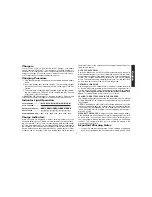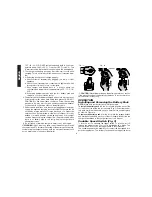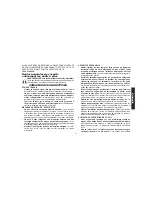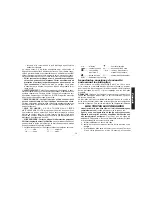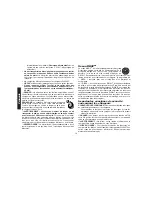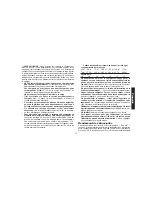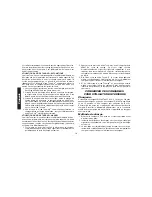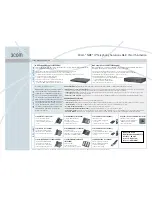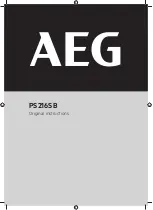
3
English
The RBRC™ Seal
The RBRC™ (Rechargeable Battery Recycling Corpor-
ation) Seal on the nickel-cadmium battery (or battery pack)
indicates that the costs to recycle the battery (or battery
pack) at the end of its useful life have already been paid by
D
E
WALT. In some areas, it is illegal to place spent nickel-
cadmium batteries in the trash or municipal solid waste stream and the
RBRC program provides an environmentally conscious alternative.
RBRC in cooperation with D
E
WALT and other battery users, has
established programs in the United States to facilitate the collection of
spent nickel-cadmium batteries. Help protect our environment and
conserve natural resources by returning the spent nickel-cadmium
battery to an authorized D
E
WALT service center or to your local retail-
er for recycling. You may also contact your local recycling center for
information on where to drop off the spent battery.
Important Safety Instructions for Battery
Chargers
SAVE THESE INSTRUCTIONS: This manual contains important
safety instructions for battery chargers.
•
Before using charger, read all instructions and cautionary markings
on charger, battery pack, and product using battery pack.
DANGER: 120 volts are present at charging terminals. Do not probe
with conductive objects. Electric shock or electrocution may result.
WARNING: Do not allow any liquid to get inside charger. Electric
shock may result.
CAUTION: To reduce the risk of injury, charge only D
E
WALT nickel
cadmium rechargeable batteries. Other types of batteries may burst
causing personal injury and damage.
CAUTION: Under certain conditions, with the charger plugged in to
the power supply, the exposed charging contacts inside the charger
can be shorted by foreign material. Foreign materials of a conductive
nature such as, but not limited to, steel wool, aluminum foil, or any
buildup of metallic particles should be kept away from charger cavities.
Always unplug the charger from the power supply when there is no bat-
tery pack in the cavity. Unplug charger before attempting to clean.
•
DO NOT attempt to charge the battery pack with any chargers
other than the ones in this manual. The charger and battery
pack are specifically designed to work together.
•
These chargers are not intended for any uses other than
charging D
E
WALT rechargeable batteries. Any other uses may
result in risk of fire, electric shock or electrocution.
•
Do not expose charger to rain or snow.
•
Pull by plug rather than cord when disconnecting charger.
This will reduce risk of damage to electric plug and cord.
•
Make sure that cord is located so that it will not be stepped on,
tripped over, or otherwise subjected to damage or stress.
•
Do not use an extension cord unless it is absolutely neces-
sary. Use of improper extension cord could result in risk of fire,
electric shock, or electrocution.
•
An extension cord must have adequate wire size (AWG or
American Wire Gauge) for safety. The smaller the gauge number
of the wire, the greater the capacity of the cable, that is 16 gauge
has more capacity than 18 gauge. When using more than one
extension to make up the total length, be sure each individual
extension contains at least the minimum wire size.
Recommended Minimum Wire Size for Extension Cords
Total Length of Cord
25 ft.
50 ft.
75 ft.
100 ft.
125 ft.
150 ft.
175 ft.
7.6 m 15.2 m
22.9 m
30.5 m
38.1 m 45.7 m
53.3 m
Wire Size AWG
18 18 16
16 14 14
12
•
Do not place any object on top of charger or place the charg-
er on a soft surface that might block the ventilation slots and
result in excessive internal heat. Place the charger in a position
away from any heat source. The charger is ventilated through slots
in the top and the bottom of the housing.








